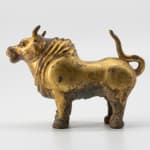Han Dynasty figure of an Ox, 206 BCE - 220 CE
Gilt bronze
width 14 cm
width 5 1/2 in
width 5 1/2 in
ES.9258
Further images
-
(View a larger image of thumbnail 1
)

-
(View a larger image of thumbnail 2
)

-
(View a larger image of thumbnail 3
)

-
(View a larger image of thumbnail 4
)

-
(View a larger image of thumbnail 5
)

-
(View a larger image of thumbnail 6
)

-
(View a larger image of thumbnail 7
)

-
(View a larger image of thumbnail 8
)

This is a superb exemplar of a Han era figure of an Ox. Details on the artworks body are intricate and are quintessential of Han dynasty production. Shown in a...
This is a superb exemplar of a Han era figure of an Ox. Details on the artworks body are intricate and are quintessential of Han dynasty production. Shown in a semi-erect stance with delightful curved horns and gentile facial expression and raised tail, signifying its feral nature. The features are finely presented on the bovine creature with a forward-faced position, with all four legs firmly rested on the ground and incised wrinkled throat adding to its endearing character and divine significance. The shoulder and rump of the animal is incised with small circular motifs and symbols evidenced in similar pieces from the Han dynasty.
Within the canon of Chinese mythology, the Ox is a valued animal, because of its role in agricultural production and is known for its diligent nature and honesty. A symbol of fortune and wealth, Oxen are also known as the strongest animal in the Zodiac for their robust and majestic form.
The Han Dynasty (206 BCE-220 CE) was the second imperial dynasty of China and one of the longest major dynasties in Chinese history. In modern terms of military and political power and cultural prestige, the Han Dynasty is currently considered to have rivalled its almost contemporary Roman Empire in the West. With only minor interruptions it lasted a span of over four centuries and was considered a golden age in Chinese history especially in arts, politics and technology. All subsequent Chinese dynasties looked back to the Han period as an inspiring model of a united empire and self-perpetuating government.
Within the canon of Chinese mythology, the Ox is a valued animal, because of its role in agricultural production and is known for its diligent nature and honesty. A symbol of fortune and wealth, Oxen are also known as the strongest animal in the Zodiac for their robust and majestic form.
The Han Dynasty (206 BCE-220 CE) was the second imperial dynasty of China and one of the longest major dynasties in Chinese history. In modern terms of military and political power and cultural prestige, the Han Dynasty is currently considered to have rivalled its almost contemporary Roman Empire in the West. With only minor interruptions it lasted a span of over four centuries and was considered a golden age in Chinese history especially in arts, politics and technology. All subsequent Chinese dynasties looked back to the Han period as an inspiring model of a united empire and self-perpetuating government.







